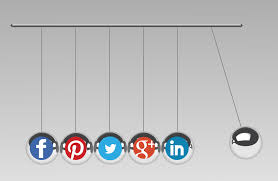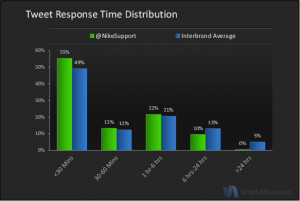So what is the difference?
The Traditional word-of-mouth (WOM), defined as an oral form of interpersonal non-commercial communication among acquaintances (Arndt, 1967), has evolved into a new form of communication; electronic word-of-mouth (eWOM). This refers to any statement made by potential, actual, and former customers about a company’s product and services via the Internet (Hennig-Thurau et.al., 2004). The advances of the Internet offer a strong ground for eWom marketing (Goodman, 2009).
You may think this is new but it’s the oldest type of marketing we know; you come across something new or funny and you share your discovery!
There is an emerging attention on the effectiveness of electronic word of mouth and it is becoming a powerful element in marketing (Godes, 2015). As online communities increase in size, number and character, marketers have come to recognize word of mouth’s growing importance (Meuter, McCabe and Curran, 2013).
Related Reading: What is Electronic word of mouth Marketing?
The power has shifted…
The power has shifted to the consumer, people trust people; not marketers or adverts (Morris, 2009).
According to (Neilson, 2015) a staggering 92 percent of consumers around the world say they trust earned media, such as recommendations from friends and family, above all other forms of advertising. Therefore sometimes it does not matter how effective your campaign is because a bad review through the internet can destroy it quickly (Goodman, 2009).
What elements make Electronic Marketing so powerful ?
#1 The audience size
The effectiveness of eWom Marketing has been increased due to the reliance of social media platforms rising. With over 1.19 billion monthly active Facebook users a message or discussion has the potential to go viral. There has been a dramatic increase in conversations via twitter about brands and campaigns (Akyol, 2013). Other strategies cannot compete with audience size (Pohlman, 2014).
Simple: An Increase in discussions = An Increase in Brand Awareness
Success Story: #Tweethearts
Introducing #Tweethearts: the mash-up of Sweethearts and Twitter. The #Tweethearts social campaign allows users to create customized Sweethearts candy hearts using Twitter. This created discussions on all other social Media platforms too, such as; Instagram and Facebook. With zero media dollars spent, they reached we over 2 million users . Buzzfeed featured #Tweethearts on its homepage resulting in over 45,000 people seeing it.
Who needs billions for advertising?
View the entry here. Tweethearts
#2 Easy to Measure
Social Media platforms create an easy method for us to measure the interaction, either by figures or simply the content in status updates (Akyol, 2013).
Example: MTV measure the discussions of the most popular TV programmes through ‘hashtags’ on social media. The more popularity shown gives the winner of the best series over a certain period of time.
#3 Assists with consumers behaviours
Over 80% of consumers will now research a product through the internet before purchand thus showing that reviews are becoming vital for companies because they have a chance to alter consumers behaviours and attitudes (Akyol, 2013).
Related Reading: Why customer reviews are so important
So whilst analysing word of mouth marketing it is important to remember the ‘THREE E’s’.
#1 ENGAGE
“Give your fans the gift of you”
It is beneficial to be a part of the on-going conversations about your particular brand. If you are involved you can spot trends or problems at the same time understanding the way your audience thinks (Haig, 2005).
Example: @NikeSupport is an excellend example of customer service carried out well. This company are knownfor constantly responding to followers on social ‘s Twitter, Instagram or Facebook. Maybe take a look for yourself? You can see them respond to someone new every few minutes!
#2 EQUIP
“Give them a reason to talk”
Either through outstanding products, amazing services, personal knowledge, incredible stories or even funny facts! You must be able to understand your consumers and provide exactly what they want (Haig, 2005).
Example: Apple delivers remarkable devices to customers, allowing them to naturally raze about the latest technological gadget being released. There has been an increase in discussions through all social media channels about the New I Watch.
#3 EMPOWER
“Give your consumers unique and different ways to talk and share”.
Not just standard discussions on social media. Perhaps find a way to help share their opinions within their circles and find methods to move conversations around locations (Pohlman, 2014) .
Example: Walkers created “Do us a flavour”, this allowed consumers to create a new crisp flavour to go on the store shelves. Over 3.8 million submissions were sent in 2013, this was spread virally thanks to social media and everyone was talking about it. What was your flavour?
For more information about the 3 E’s check out this article.
However,
In the case of eWom, the receiver is not always familiar with the sender of the information. Therefore eWOM is less trusted (Morris, 2009). With the digital world growing, we don’t know exactly who we are listening to and this means there is always a risk when the internet is involved.
What happens when a customer tells another a bad experience about your business? According to Morris (2012), a personal account that is negative in nature can have a lasting effect on your company.
And finally what happens if your target audience is the older generation? You may lose out on potential customers using this method. Check out these additional reminders for when eWom may not be suitable
To conclude this topic…
Word-of-mouth marketing can be encouraged through different publicity activities set up by companies, or by having opportunities to encourage consumer-to-consumer and consumer-to-marketer communications. Consumers have always valued opinions expressed directly to them and this isn’t going to change. This is becoming more of a vital tool the more social media expands!
Are you interested in similar blogs? Then search for #bbsdigmarket for more enjoyable reads!
Wants to TWEET about this subject
TWEET: 92 percent of consumers around the world say they trust earned media, such as recommendations from friends and family, above all other forms of advertising
TWEET: We should not forget the importance of #eWom
References
Akyol, Ş. (2013). Social Media and Marketing: Viral Marketing. Academic Journal of Interdisciplinary Studies.
Arndt, J. (1967). Role of Product-Related Conversations in the Diffusion of a New Product. Journal of Marketing Research, 4, 291-295
Consumer Trust in Online, S. (2015). Newswire | Consumer Trust in Online, Social and Mobile Advertising Grows | Nielsen. [online] Nielsen.com. Available at: http://www.nielsen.com/us/en/insights/news/2012/consumer-trust-in-online-social-and-mobile-advertising-grows.html [Accessed 2 Apr. 2015].
Godes, D. (n.d.). Product Policy in Markets with Word-of-Mouth Communication. SSRN Journal.
Goodman, J. (2009). Strategic customer service. New York: AMACOM.
Haig, M. (2005). Beyond Branding. Journal of Direct Data and Digital Marketing Practice, 7(2), pp.195-198.
Meuter, M., McCabe, D. and Curran, J. (2013). Electronic Word-of-Mouth Versus Interpersonal Word-of-Mouth: Are All Forms of Word-of-Mouth Equally Influential?. Services Marketing Quarterly, 34(3), pp.240-256.
Morris, N. (2009). Understanding Digital Marketing: Marketing Strategies for Engaging the Digital Generation. J Direct Data Digit Mark Pract, 10(4), pp.384-387.
Pohlman, B. (2014). Engage, Equip, Empower. [online] Marketingdirectorblog.com. Available at: http://marketingdirectorblog.com/2014/07/engage-equip-empower/ [Accessed 1 Apr. 2015].
Understanding digital marketing: marketing strategies for engaging the digital generation. (2014). Choice Reviews Online, 52(05), pp.52-2647-52-2647.









